Key Insights
- The macroeconomic environment did not curtail Avalanche’s development or network health throughout Q2, and the strategies to continue expanding the network were effective.
- The network experienced sharp declines in network usage due to macro forces and redirected activity from the Avalanche C-Chain to subnets.
- Avalanche’s Q2 TVL fell roughly 75% in USD terms quarter-over-quarter, but the amount of AVAX locked in DeFi increased.
- The bear market has not diminished the network’s health as staking and decentralization of the network remained strong despite recent market volatility.
- Community concerns about the redirected activity to subnets became prevalent, but Ava Labs highlighted the value accrual mechanics of AVAX.
- The continued development of subnets and the launch of Core will play a vital role in the interoperability between subnets and in further expanding the network.
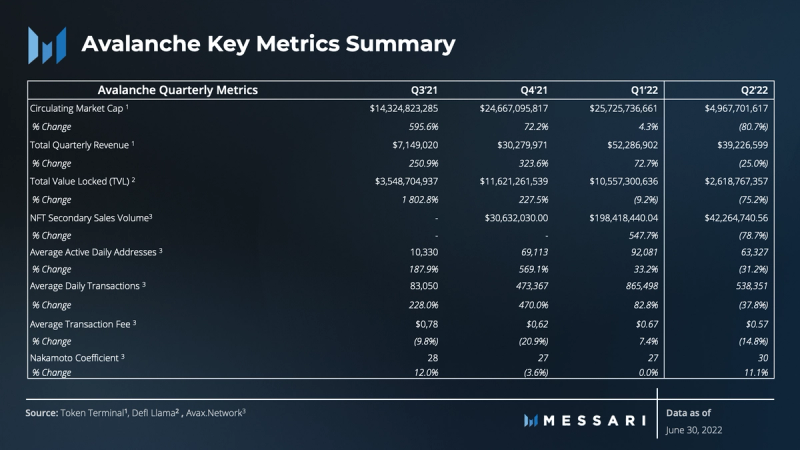
A Primer on Avalanche
The Avalanche network is a Proof-of-Stake (PoS) smart contract platform for decentralized applications. Whereas most competitors use consensus mechanisms in the Classical or Nakamoto families, Avalanche differentiates itself by creating and implementing a new consensus family known as “Avalanche consensus.” Following years of research, the Avalanche mainnet was launched in September 2020 and featured the release of a multichain framework utilizing three chains (the P, X, and C chains). Each chain plays a critical and unique role within the Avalanche ecosystem while providing the same capabilities of a single network.
As a follow-up to the State of Avalanche Q1 2022 report, this report will revisit developments and events from the prior quarter, analyze the network’s most recent quarterly performance, and give insight into the coming months. A complete appendix of data tables is available at the end of the report.
The Second Quarter Narrative
After unprecedented growth during 2021, the Avalanche network experienced stable growth in usage metrics, maturing infrastructure, and increased financial performance in Q1 2022. The outcomes of Q1 were attributed to several key developments, including executing growth strategies, subnet development, and ecosystem expansion into new sectors. The outlook for Q2 2022 was positive, and continued success was expected.
In Q2, however, cryptocurrencies and network activity throughout the crypto sphere declined dramatically as the Federal Reserve began hiking interest rates and a $60 billion collapse of terraUSD and LUNA unfolded. Avalanche indeed felt the macroeconomic environment as we saw declines in financial metrics and network usage. With that in mind, the bear market has not curtailed Avalanche’s development or its health and ecosystem. Improving user experience was a high priority heading into Q2. As part of this effort, Ava Labs successfully launched Core; a free, non-custodial wallet explicitly created for applications on Avalanche with native support for subnets. Further, Ava Labs also successfully enabled native Bitcoin support on Avalanche Bridge, allowing BTC holders to securely transfer their BTC onto Avalanche. Ultimately, while macro forces impacted Avalanche’s valuation and network activity, the strategies to continue expanding the network were effective throughout Q2.
Network Overview
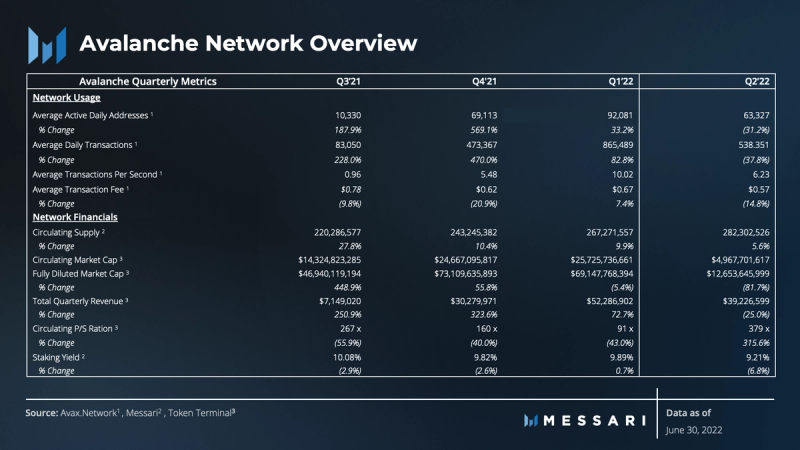
Across the board, Avalanche experienced declines in network usage and financial performance compared to the prior quarter and for the first time in over a year. While the market cap declined dramatically (-81.7%), the network did not experience as much of a decline in usage and revenue generation. Average daily transactions were cut by a third (-37.8%), total revenue declined by 25%, and the price-to-sales (P/S) ratio reversed course, with the ratio of price relative to revenue growing from 91x to 379x.
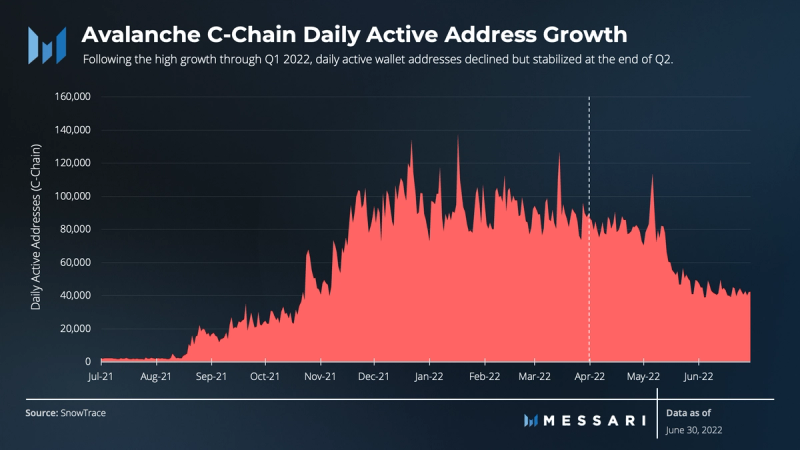
Daily active addresses also reversed course, with market sentiment driving address activity down from the all-time-high of 140,000 in Q1 2022. While on a downtrend trend over Q2, daily active addresses stabilized at around 42,000 per day on average during June. For perspective, this amount of activity is still exponentially greater than where the network was just a year prior. The network averaged around 92,000 daily active addresses during Q1 and reached a stable range with an average of 63,000 during Q2.
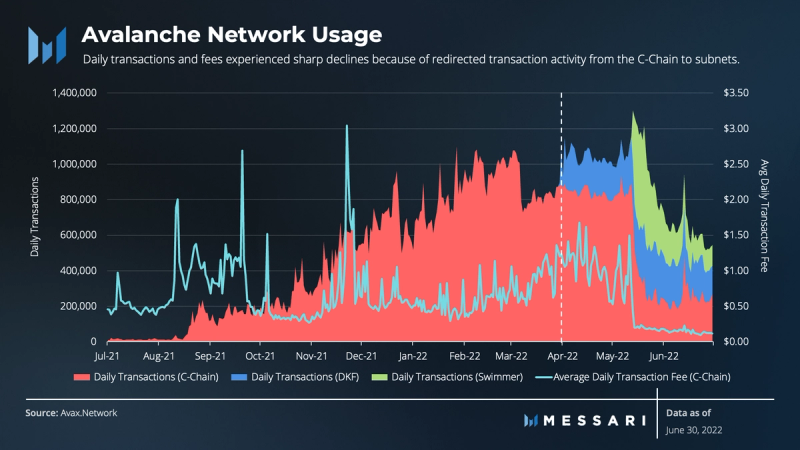
Similar to Q1, transaction activity on the network followed the pattern of daily active address activity. Overall, Avalanche’s average daily transactions declined from 865,000 last quarter to 540,000 in Q2. Daily transactions experienced sharp declines because last quarter’s GameFi developments redirected transaction activity from the C-Chain to subnets such as “DeFi Kingdoms: Crystalvale” and “Crabada.”
As an application on the C-Chain, Crabada became the top transaction driver on Avalanche during Q1. During Q2, both subnets went live with their networks and native tokens. Collectively, the subnets generated an average of 900,000 transactions per day that otherwise would have been processed on the Avalanche C-Chain. To that end, the shift in transactions from the C-Chain to the individual subnets put downward pressure on Avalanche transaction fees (as designed) and material downward pressure on revenue.
Throughout 2021 and into Q1 2022, the network continued to experience volatility in average daily transaction fees. Several Apricot patch releases further stabilized average transaction fees, reducing them from $1.23 in 2021 to $0.67 in Q1 2022.
After Apricot came subnets, and as expected, the launch of subnets simultaneously put downward pressure on transaction fees. Since the launch of subnets (especially with the Swimmer network in May), the network experienced a sharp decline in transaction fees (-15%), decreasing to an average of $0.57.
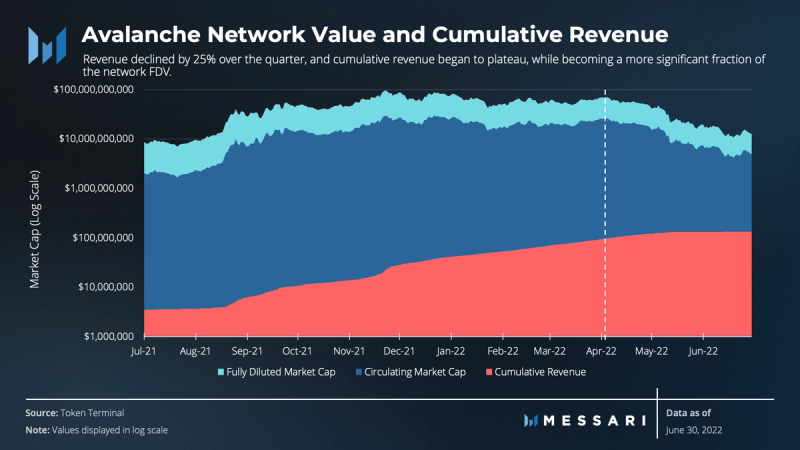
As can be expected, total revenue also declined as average daily active addresses, daily transactions, and transaction fees declined. Revenue declined by 25% over the quarter, and cumulative revenue began to plateau, while becoming a more significant fraction of the network FDV.
Unlike other smart contract platforms, Avalanche burns 100% of transaction fees from the network’s circulating supply. By increasing scarcity, value is created for all token holders rather than compounding the balances of validators and delegators. Thus, revenue growth or declines will influence AVAX’s market value either upwards or downwards. It is important to determine whether the spread between revenue and market value is statistically significant. Therefore, a strong correlation between revenue and market value should theoretically exist as fundamental value (as opposed to speculative value) becomes a more substantial part of market value.
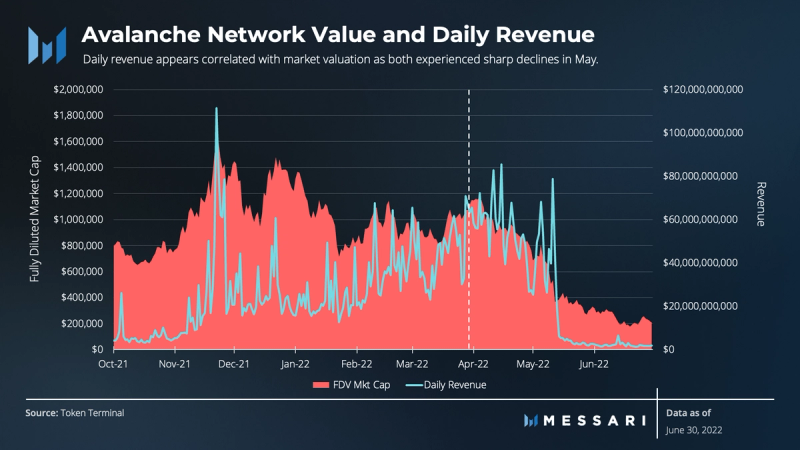
In Q1 and Q2, spikes in daily revenue were accompanied by spikes in FDV. In addition, the spread between the two variables tightened in Q2, with occasional spikes in revenues accompanied by spikes in FDV. As the spread tightens, the network usage becomes more correlated to the market value. As stated in previous reports, this correlation could indicate that the network is moving closer to fundamental value versus speculative value. And also, as stated in previous reports, if the relationship holds, revenue will have a significant relationship with network value.
To that end, the launch of subnets seemingly impacted both transaction fees (lower) and the number of transactions processed on the Avalanche network (less), thereby putting downward pressure on revenue. While macro forces were also at play during Q2, the relationship between revenue and network value remains intact as valuation experienced a sharp decline simultaneously. This then begs the question of whether subnets will negatively impact the utility of the AVAX token and the Avalanche network value.
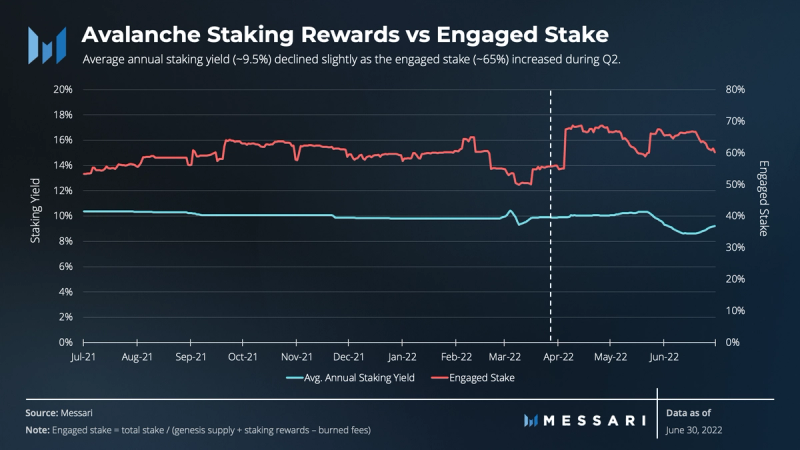
Despite the overall marketwide volatility during Q2, engaged stake and staking yields have been stable on the Avalanche network, with an average annualized yield of ~10%. One of the last significant token unlocks occurred in March 2022, but there was no indication of a change in engaged stake shortly after. Since then, and over the course of Q2, there was a slight uptick in engaged stake and, therefore, a slight decline in staking yield. Whether this decline is from token unlocks remains unknown.
Ecosystem & Development Overview

Despite ongoing incentive programs, Avalanche’s Q2 TVL fell roughly 75% in USD terms quarter-over-quarter.
This downturn wasn’t isolated to DeFi and spilled over into Avalanche’s nascent NFT market, leading to quarter-over-quarter declines in secondary sales volume (down 78.7%) and unique buyers (down 54.3%). Notably, secondary sales dropped in May, around the time of the Swimmer network subnet launch.
The total unique contracts deployed brought a silver lining, bucking the trend and growing 154.7% over the quarter. Avalanche network developers also had one of their most productive quarters, with activity (measured by new GitHub events) up 76.4%.

While TVL in USD was down, the amount of AVAX locked in DeFi increased. The quarter began with ~115 million AVAX locked in DeFi and finished with ~152 million. From this perspective, TVL and value were actually captured, and the decline in TVL stated in USD is merely the result of the decline in AVAX price, not utilization.
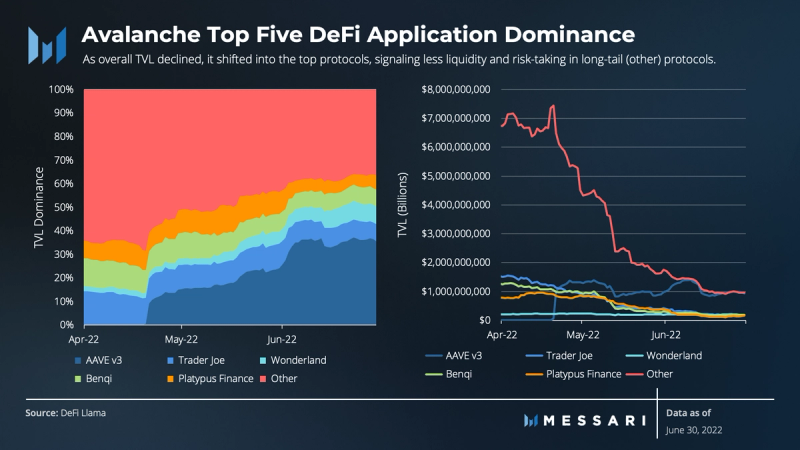
Avalanche’s two most prominent lending protocols, Aave and Benqi, saw their TVLs dip roughly in line with the Avalanche DeFi ecosystem as a whole (69.3% and 76.7%, respectively). At the same time, leading all-in-one DEX Trader Joe sustained a much steeper decline (87.9%). Interestingly, as overall TVL declined, it shifted into the top protocols, signaling less liquidity and risk-taking by way of liquidity farming in long-tail (other smaller) protocols. Despite the category leaders being down, the broader DeFi ecosystem was able to hold its ground thanks to other projects such as Olympus DAO fork Wonderland (only down 28.3% in TVL) and new projects such as Yeti Finance.
Within 24 hours of its launch (in mid-April), Yeti Finance, an Avalanche-native borrowing protocol, pooled over $500 million in TVL. While this figure came down by the end of the quarter (to $215 million), Yeti nevertheless unlocked a new source of sustainable TVL. In all likelihood, this top 10 (by TVL) protocol attracted users that wanted to borrow against their interest-bearing tokens (e.g., LP tokens). It thus contributed to the increase in locked AVAX over the quarter.
Q2 also marked the beginning of Avalanche’s highly anticipated GameFi subnet launches. Before its subnet went live at the end of May, Crabada reached as many as 7,000 users, measured by the number of unique wallet addresses interacting with the application’s smart contracts. Daily transactions grew to ~500,000 over Q2, measured by transactions made to Crabada’s smart contracts. The daily volume also generally ranged around $425,000. Finally, the TVL in the application’s smart contracts neared $100 million before the subnet went live.
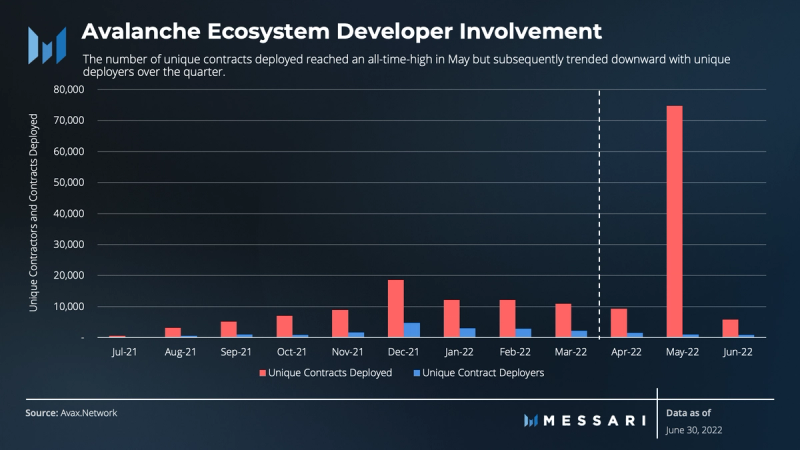
Q2 developer activity in the Avalanche ecosystem closely mirrors overall market activity (e.g., TVL). Despite the general trend, thanks to a massive, anomalous surge in May, the number of unique contracts deployed grew by 154.7% quarter-over-quarter. The number of unique contract deployers showed a considerable drop-off with a decline of 58.8%.
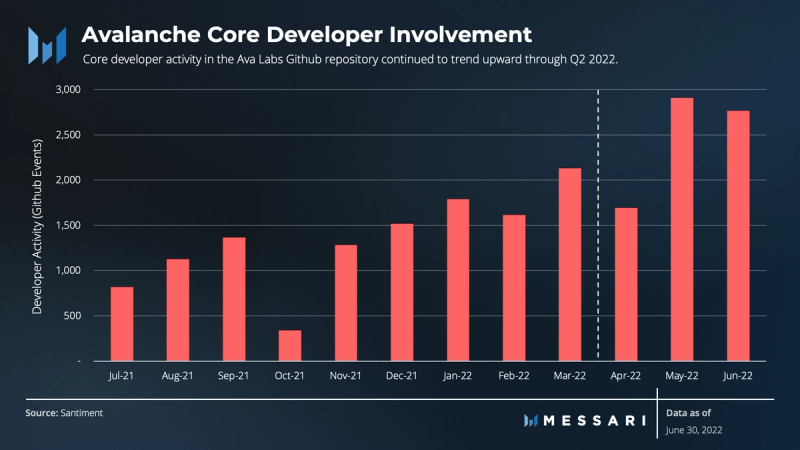
Despite market conditions, the events in the Ava Lab’s Github repository grew meaningfully (33.1%) throughout Q2. Seeing as this was the second-largest increase to date, the network’s core contributors appear to be finding success in the infrastructure buildout.
Staking and Decentralization Overview
The security of PoS networks like Avalanche requires users to lock up the network’s native tokens and participate in validation duties. A distributed network of validators and active participants can help ensure the network functions as intended.
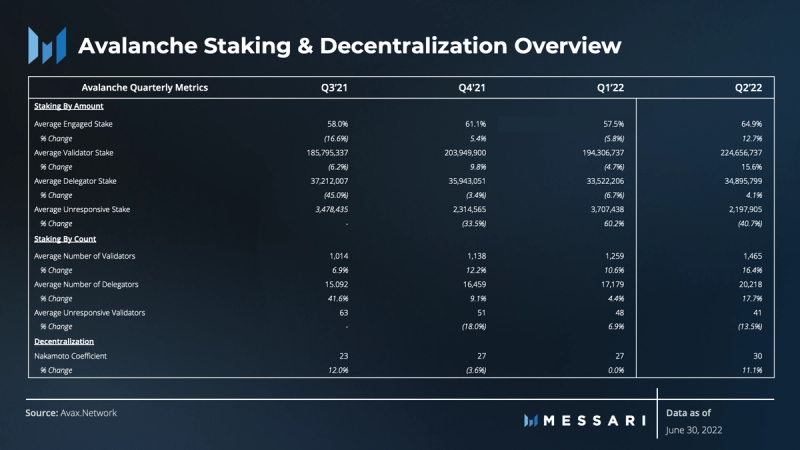
While the macroeconomic environment may have negatively impacted the Avalanche ecosystem, the bear market has not diminished the network’s health. Staking and decentralization of the network remain strong despite recent market volatility.
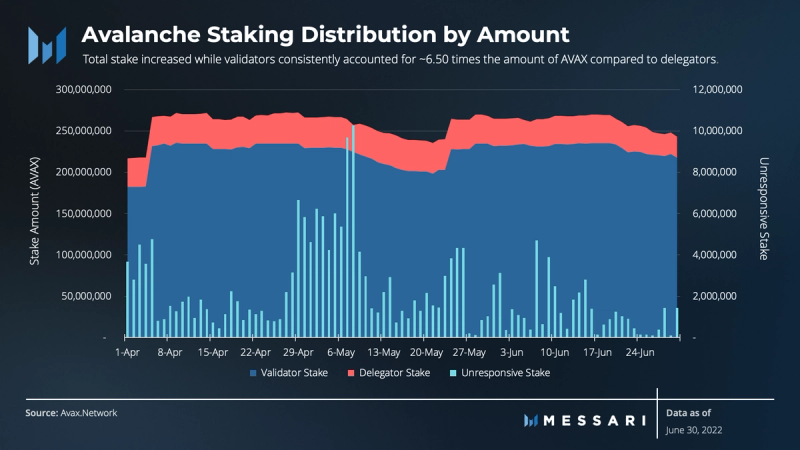
Staking activity experienced a material shift compared to previous quarters. The average stake grew by as much as 16% quarter over quarter. Validator stake was consistently 6.50 times greater than the amount of delegated stake. The unresponsive validator stake also declined significantly (by 40.7%), which signals greater engagement, reliability, and network health.
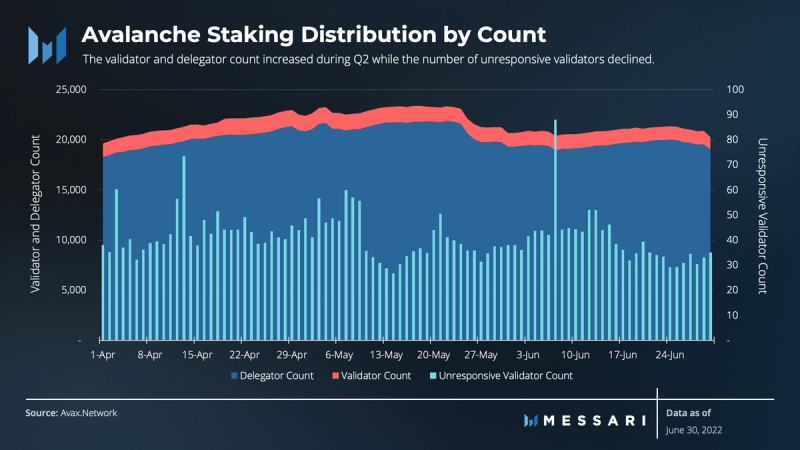
Similarly, there was a material increase in the average number of validators and delegators. The average validator count grew from 1,259 to 1,465, representing a 16.4% increase in network security participants. At the same time, the average number of unresponsive validators declined (by 13.5%).
As mentioned previously, the launch of subnets may prompt some to ask whether subnets minimize the accrual of value to the Avalanche network and the AVAX token. With that in mind, each new Avalanche subnet must validate on the Avalanche P-chain and stake AVAX. As more subnets launch, the average number of validators should increase in tandem with the amount of AVAX staked.
Further, the average number of delegators grew significantly from 17,179 to 20,218, representing a 17.7% increase. The number of delegators consistently outnumbered the number of validators, consistent with other PoS networks that support native delegation. In the end, low volatility and growth in stake, validator, and delegator counts signal a healthy network and progress towards greater decentralization.
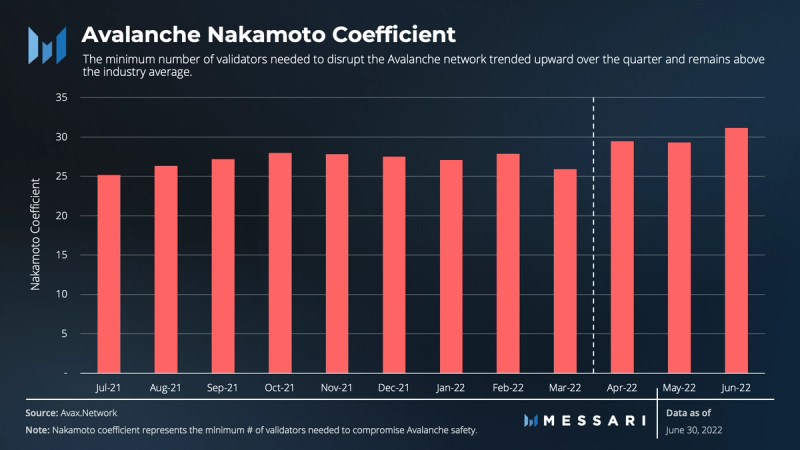
Avalanche’s Nakamoto coefficient hovered around 30 throughout 2021. During Q1 2022, it fell to the mid-20s. But because of the increase in validator count and stake, it reverted to 30 in Q2. The improvement continues to put Avalanche above the industry average compared to other Layer-1 networks.
Competitive Analysis
Currently, the Layer-1 space is a competitive race between new and legacy protocols to achieve the maximum possible network speed at the lowest possible cost and with the greatest degree of security. Each competitor has focused on maximizing these activities while making a range of trade-offs regarding centralization. The ideal blockchain would be fast, secure, widely used, and adequately decentralized.
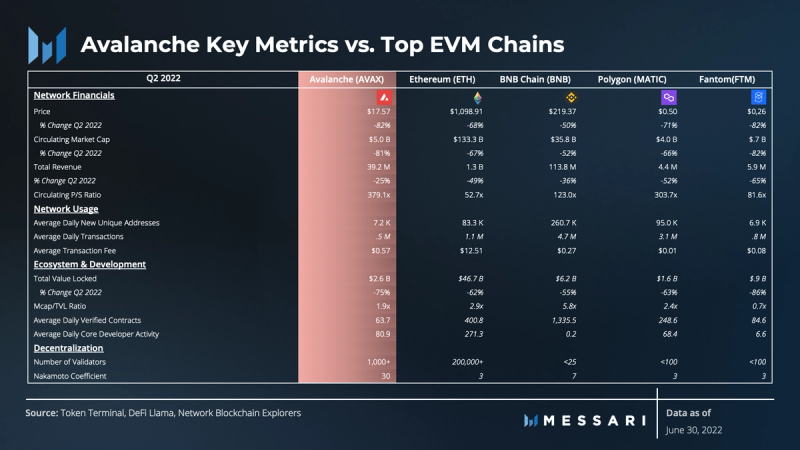
Technical advancements, developer activity, and ecosystem growth strategies separate L1s from each other. Here, we evaluate Avalanche’s key metrics versus the top five EVM-compatible chains (including Avalanche) by TVL and the largest number of DeFi protocols. This peer group was derived by simply grouping the EVM chains with the largest TVL and greatest number of protocols, seeing as today DeFi is the sector driving the majority of each network’s economic activity.
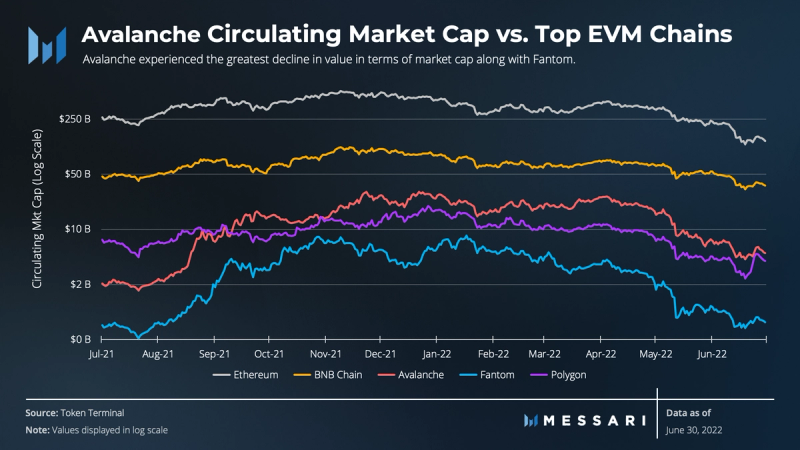
Avalanche experienced the greatest decline in value in terms of market cap along with Fantom. As a result, Ethereum, BNB Chain, and Polygon regained market cap dominance over the quarter.
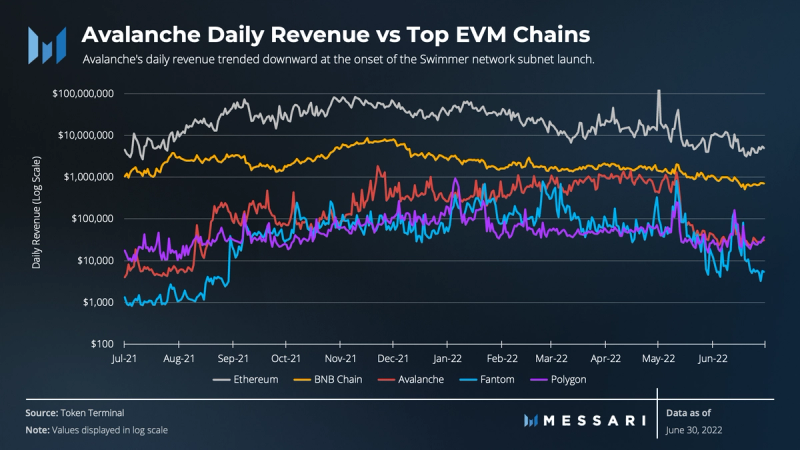
Similarly, Avalanche’s daily revenue trended downward at the onset of the Swimmer network subnet launch. Despite the sharp decline in May, the total decline in revenue quarter over quarter was less than the decline experienced across the peer group. Overall, revenue was strong early in the quarter and supported the subsequent decline.
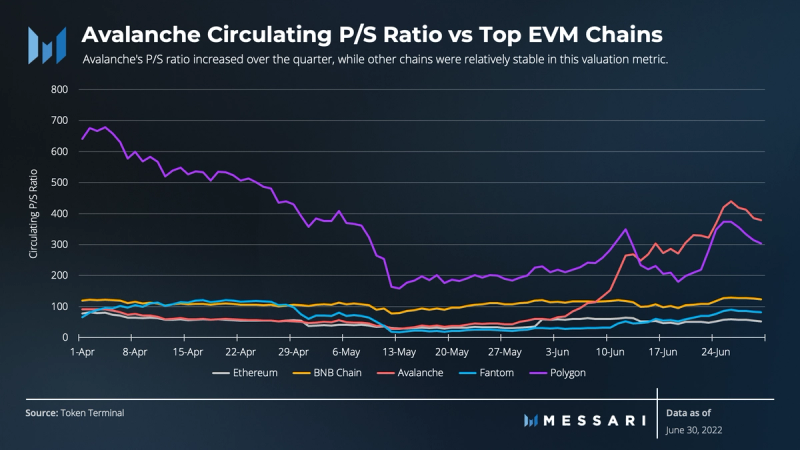
Avalanche’s P/S ratio increased over the quarter, while other chains were relatively stable in this valuation metric. Polygon experienced a material decline, and from a relative valuation perspective, Avalanche is now more in line with Polygon with a P/S of 379x versus where it was compared to Ethereum last quarter.
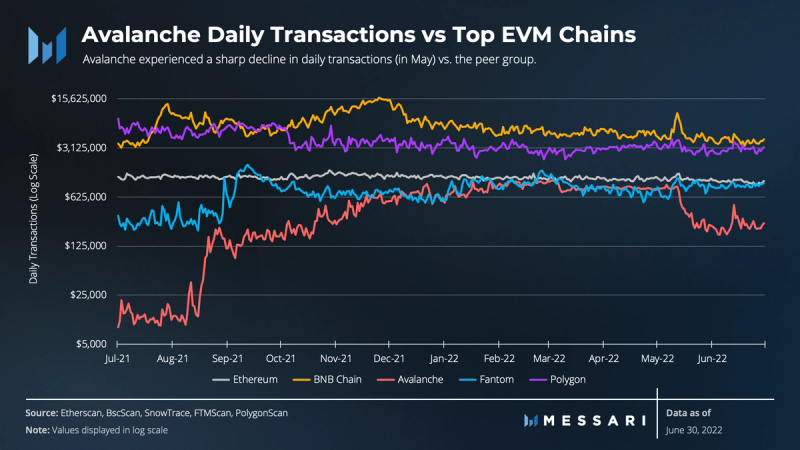
Avalanche had reached similar levels of daily transactions compared to Ethereum throughout Q1 and the earlier part of Q2. Again, with the launch of the Swimmer network subnet in May, daily transactions on the C-chain experienced a sharp decline. Ethereum has held steady at ~1.17 million transactions per day, with Avalanche reaching as much as ~74% of Ethereum’s average daily transactions, but now hovers closer to 50%.
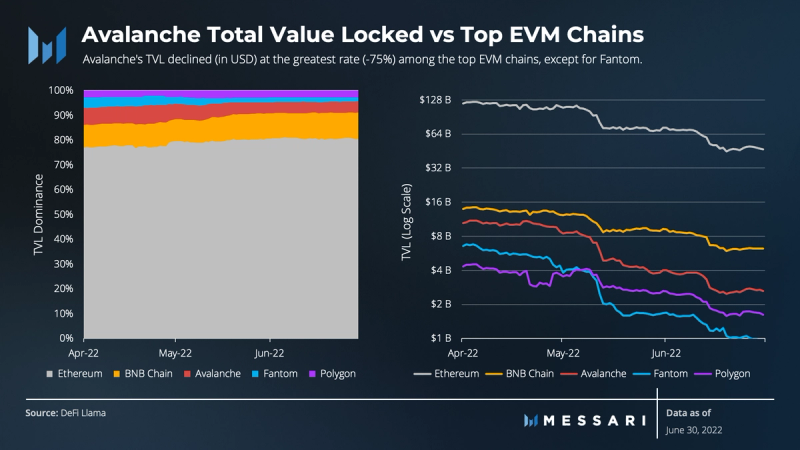
Q2 was a down quarter for the crypto market, with aggregate TVL decreasing from $228 billion to $75 billion, representing a 67% decline in USD terms. Avalanche’s TVL declined at the greatest rate (-75%) among the top EVM chains, except for Fantom. A significant portion of Avalanche’s decline in TVL may have come from exposure to the collapse of terraUSD. As mentioned earlier, declines in TVL are generally evaluated in USD. Therefore, the asset’s decline in value represents the shift in price versus the actual utilization of DeFi. Ultimately, while TVL in USD was down, the amount of AVAX locked in DeFi went up.
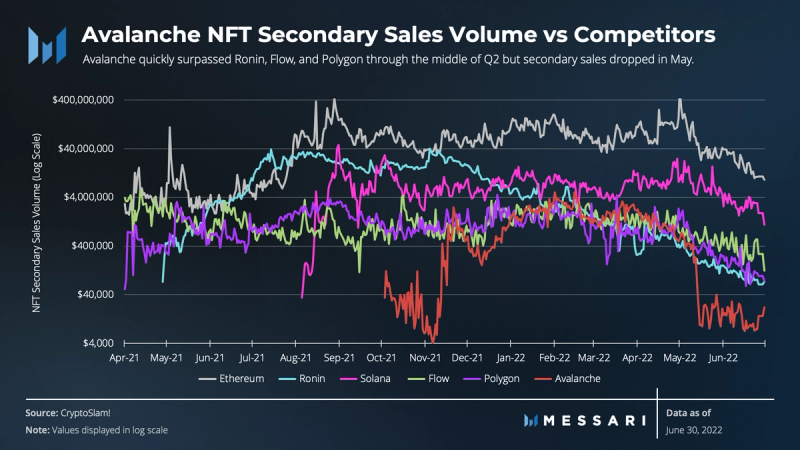
Avalanche was on a path to establishing a strong position relative to a peer group of the top L1s by secondary NFT sales volume. Avalanche quickly surpassed Ronin, Flow, and Polygon during Q1 and the early part of Q2. However, secondary sales dropped in May, around the time of the Swimmer network subnet launch. Nonetheless, Avalanche has moved into the top 10 in terms of all-time sales volume in a short period. Similarly, Avalanche’s path to attracting unique buyers followed the same pattern as secondary sales.
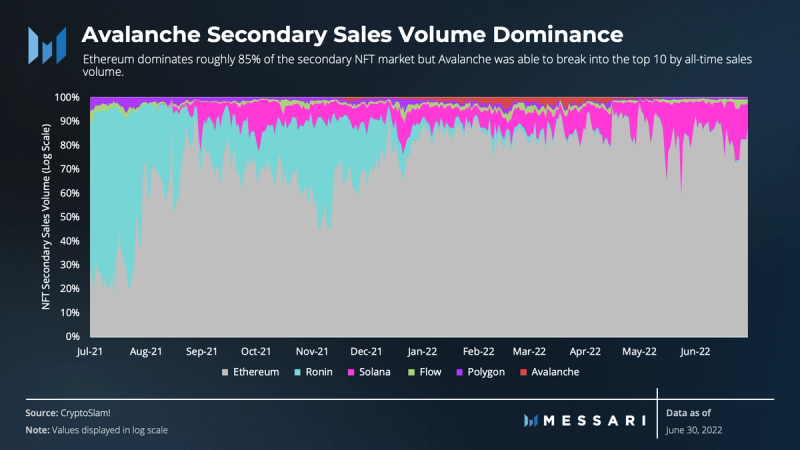
Though Ethereum still dominates roughly 85% of the secondary NFT market, Avalanche was notably able to break into the top 10 by all-time sales volume.
Key Events, Catalysts, and Strategies for Ecosystem Growth
Like many other networks, Avalanche also felt the weight of the macroeconomic environment. The network experienced declines across the majority of metrics. However, the bear market has not diminished Avalanche’s development or its health and ecosystem. Ultimately, while macro forces impacted many of Avalanche’s metrics, the expansion strategies were effective throughout Q2 and can be attributed to several key developments:
- Beta release of Ava Labs’ Core wallet and native BTC Bridge
- The second major subnet deployment (Swimmer Network)
- Roll out of Trader Joe’s NFT marketplace Joepegs
- Launch of borrowing protocol Yeti Finance and its stablecoin YUSD
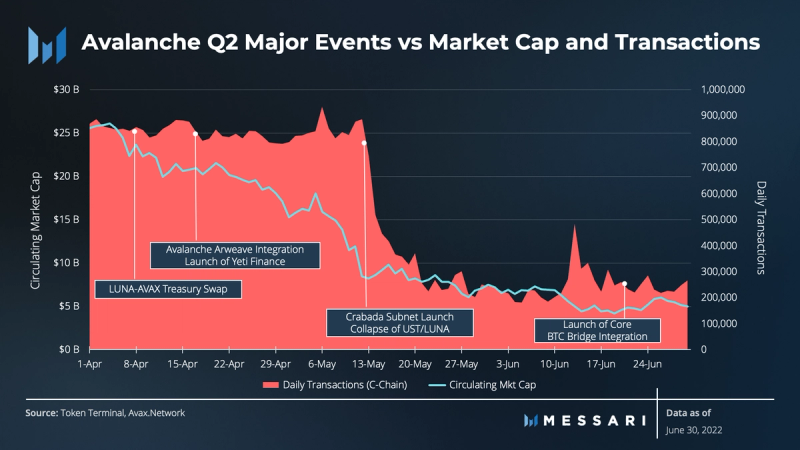
April 2022
Q2 started with the much-anticipated launch of Degis, the first native insurance protocol on Avalanche. Degis began its rollout of a comprehensive product suite for the ecosystem. Later in the month, the decentralized data storage protocol Arweave expanded to Avalanche, allowing users to directly store data in Arweave’s “blockweave.”
Another major launch was the mainnet of Avalanche-native borrowing protocol Yeti Finance. This allows users to borrow its overcollateralized stablecoin, YUSD, against their interest-bearing tokens. Within 24 hours of launch, Yeti pooled over $500 million in TVL. Despite this number coming down, it still sits in the top 10 on Avalanche with YUSD having the second-largest Curve pool.
Finally, towards the end of the month another high-profile Web2 game developer, Pocket Worlds, announced plans to expand its flagship game, Highrise World, onto its own subnet.
May 2022
The most notable event in May was the migration of C-Chain-based play-to-earn (P2E) game Crabada to its own subnet, the Swimmer Network, making it Avalanche’s second major live subnet. Another milestone for the ecosystem was the launch of Avvy Domains, which allows users to create and manage .avax names.
May was also a notable month for Avalanche NFTs. Leading DEX Trader Joe launched its own NFT marketplace, Joepegs. Additionally, NFT platform RECUR integrated Avalanche, allowing its users to move NFTs to the network. Snail Trail, Avalanche’s first NFT-based P2E racing game, also garnered attention.
June 2022
June saw the much-awaited (beta) release of Core, Avalanche’s first comprehensive browser extension and mobile wallet. It enables users to access the entire network and ecosystem and natively swap and bridge assets. This release also included the native BTC Bridge (only available through Core as of this writing).
Two significant events in Avalanche DeFi were the launch of Avalanche’s first native perpetual futures exchange, EMDX, and Aave’s added support for sAVAX.
Ecosystem Challenges
Q2 did not present any adverse outcomes stemming from technical challenges. Avalanche successfully launched subnets, Core, and native Bitcoin support on Avalanche Bridge. The network also succeeded in lowering transaction fees, which have presented challenges in the past.
As much as subnets are designed to increase scalability, the community is concerned about their impact on the primary network. The potential for reducing demand for AVAX became a hot topic from a community perspective. The concern is that subnets will reduce the amount of AVAX being burnt and feed transaction volume and value accrual away from the primary network. The recent launch of subnets may have created a short-term impact that will bring greater benefit over the long term.
With that in mind, the builders of Avalanche have reiterated that there is value to be realized in the collective locking of more AVAX for operating validators. In addition, fee burning on the C-Chain and strategies to grow its adoption are still intact.
Also, subnets that run on their tokens must provide liquidity for their gas tokens. For example, Treasure Under Sea (TUS) and Crabada (CRA) tie up $3 million of AVAX just for AMMs.
Further, the launch of subnets that want to retain neutrality will use AVAX as gas, and inter-subnet communication may also employ AVAX.
While value accrual concerns have been expressed by the community, managing the communication and expectations around the impact of subnets will be a challenge to address going forward.
Lastly, interoperability and creating a user-friendly experience between subnets remain top of mind for the Avalanche ecosystem. Stakeholders are advancing this effort as contributors continue building infrastructure for cross-subnet communication and native transfers.
The Road Ahead
As of now, Avalanche does not provide a roadmap for its protocol development that is publicly accessible, so plans are not explicit. However, incentive programs are expected to continue to drive DeFi growth, expand the ecosystem into new sectors, develop subnets, and usher creative talent into the ecosystem.
Additionally, core platform upgrades are expected to continue. Significant upgrades (Apricot) are being implemented in six phases, following a successful series of Phase 5 in Q2. Apricot generally represents one of the solutions (pruning) to optimizing transaction fees.
Avalanche on-chain governance is also still in development. AVAX will, at some point, be used to provide on-chain governance for critical network parameters where participants can vote on changes to the network and settle network upgrade decisions democratically. These parameters will include the minimum staking amount, minting rate, and transaction fees.
While all Avalanche incentive programs may continue to catalyze ecosystem growth, significant technological advancements are still on the horizon — most notably, the continued development of subnets and the launch of Core. Alongside Core, the interoperability and user-friendly experience between subnets are a likely focus over the coming months.
Closing Summary
Overall, Q2 was a challenging quarter for Layer-1 networks and cryptoassets. Macro forces put downward pressure on networks and diminished user activity across the board. Despite these drawbacks, the building process continues forward. As with Avalanche, we saw a successful rollout of technology that included subnets, Core, and the BTC cross-chain bridge integration. Unique smart contracts and contract deployers continued to grow, and activity on the Avalanche Github repository increased significantly. Further, the network remains healthy: staking and decentralization of the network are strong despite recent market volatility.
The community raised more concerns about daily transactions experiencing sharp declines because of redirected transaction activity from the C-Chain to subnets. Ava Labs reiterated its conviction of the value accrual mechanics surrounding the ecosystem and AVAX, such as the collective locking of more AVAX and expansion of validator sets. Additionally, ongoing strategies to drive the growth of the C-Chain are still in full force.
Ultimately, despite the current market conditions, it will be business as usual for the Avalanche ecosystem and community over the coming months. Incentive programs are expected to drive growth and development, as the core platform continues to be upgraded. Perhaps most importantly, the continued development of subnets and the launch of Core will further expand the network, placing the focus on interoperability and user experience between subnets over the coming months.
Looking to dive deeper? Subscribe to Messari Pro. Messari Pro memberships provide access to daily crypto news and insights, exclusive long-form daily research, advanced screener, charting & watchlist features, and access to curated sets of charts and metrics. Learn more at messari.io/pro
This report was commissioned by Ava Labs, a member of Protocol Services. All content was produced independently by the author(s) and does not necessarily reflect the opinions of Messari, Inc. or the organization that requested the report. Paid membership in Protocol Services does not influence editorial decisions or content. Author(s) may hold cryptocurrencies named in this report.
Crypto projects can commission independent research through Protocol Services. For more details or to join the program, contact ps@messari.io.
This report is meant for informational purposes only. It is not meant to serve as investment advice. You should conduct your own research, and consult an independent financial, tax, or legal advisor before making any investment decisions. The past performance of any asset is not indicative of future results. Please see our terms of use for more information.
Appendix
























